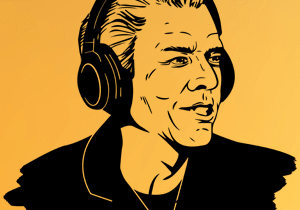
For today’s #TBT flashback post, we’re taking a very brief junket to our recent past – just three years ago back to 2021. But it feels like a lifetime ago.
That’s because we were still very much in the throes of the pandemic. And most of us weren’t having a whole lot of fun. Those predictions that COVID would be short-lived or would “just disappear” turned out to be wishful thinking, at best. The fact is, life in most of the world and here in the U.S. was tense and very emotional in the spring of 2021.
In fact, that’s what this blog post was all about – the audience’s emotional connection to a favorite radio station, and why this was so important in the midst of a global health crisis. And as we know, many radio stations in both the commercial and public sectors have struggled ever since. The malaise would seem to go beyond just the rationalization that work from home has suppressed our limited commute time, and therefore has taken a toll on radio listening in many markets.
For radio, it has always been more about connection over cume, and relevance over reach. Here we are, four years after the pandemic, and many people are still feeling vulnerable, tense, and unsure. This might help explain why Christian music radio is in the best position it’s been since we launched our Techsurvey on their platform a decade ago. Many of these stations have provided both emotional and spiritual support to audiences at a time when they needed it the most.
Regardless of format, emotion continues to play a key role in what separates the winners from the also-rans in radio three years later. Paul and I presented the results of a survey we conducted for Children’s Miracle Networks Hospitals at a conference earlier this week. It was an emotional few days as we heard from numerous “Champions” and their families – kids who received life-saving health care from their local children’s hospital and were eager to share their stories. Radio pros active in this important initiative were also on hand this year, representing many key radio companies, sharing their emotions with the kids, their parents, and each other during get-togethers where we experienced the beauty and value of “the feels.” It was quite a moment for a radio medium often struggling to regain its equilibrium.
Among other things we learned from this research is when emotions are involved – yes, those undefinable “feels” – listeners connect with Radiothons and the kids whose stories are being told. Sometimes we all need that “reality check” when the going has indeed gotten rough for so many in radio broadcasting today. This CMN Hospitals event was an important reminder of radio’s ability to perform miracles in local markets all over the U.S., even when budgets are depleted and staffs have been thinned. Yes, I indeed got “the feels.” – FJ
April 2021
Say what you will about COVID and 2020. It’s been a highly charged emotional time. No matter how you, your family, and your co-workers have navigated these past 14 months, emotions have run ragged.
This period will underscore the need for better mental health treatment in communities throughout the U.S. And sadly, this rash of mass shootings point to the emotional wear and tear so many are feeling. Yesterday, Dr. Fauci referred to it as “a public health crisis.”
And that brings us to the ways in which mass media can move us during difficult times. While “we’re all in this together” and similar catch-phrases became ubiquitous during the early innings of the pandemic, the ways in which brands have performed during the crisis have been very much dependent on their Emotional Intelligence – their ability to “read the room.”
A much-quoted line from the always prescient Maya Angelou sums it up very well:

From my perch as a radio content creator, in fact, I take it as a challenge. We need to do more than focus on “quarter-hour maintenance” or “build cume.” Those tasks even sound mechanical – like an oil change or an audit.
We’re programmers. We need to enchant, entertain, touch, and connect with our listeners. That’s the art of this craft.

Nick Michaels
I’ve been thinking about the late Nick Michaels these days. He passed away suddenly nearly three years ago. I’m betting he was a Maya Angelou fan.
Nick hated the banal, cliché ways programmers wrote copy for him – “Text in to win,” “The most music with less talk,” “Listen at home, at work, or in your car.” To Nick, this was absolute drivel. Better put and in his words, pure crap.
He had a way of boiling down what we do to precious few words. Rather than exhort the audience to “Be my 9th caller RIGHT NOW” (or as Nick would scream, “You’re not talking to the dog!”), his simple three-word suggestion was this:
“Make them feel.”
In radio, we conveniently love to pigeon-hole people by the formats they listen to most. “He’s a Classic Rocker.” “She’s into love songs.” “They’re news junkies.”
But as we learned during the proliferation of the iPod, our music collections – and the breadth of our tastes – tend to be more eclectic than simple format boundaries. We have our “guilty pleasures” – songs that don’t fit our algorithmic profiles, but have the ability to spark emotions and conjure up memories. Depending on the mood and the moment, a great Hip-Hop song, a Sinatra smash, an Elvis ballad, or a Pantera thrasher may be just what we need. Maybe not all the time, but at that intersection of emotion and real life.
Radio programmers are a pretty savvy lot, having been around for decades, working their magic over the airwaves. But it took Spotify to confirm what we’ve known all along – mood and emotion often drive our musical desires. That’s why there are so many emotionally-based playlists with labels like “Come dance with me,” “3 a.m.,” “Vibing and grinding,” “Lost in you,” and “Therapy session.”
It’s about “the feels.”
You don’t generally see radio labels like “Hot AC,” “Churban,” “Variety Hits,” or “Hot Talk” when people are putting together their mood-driven playlists. Even so, radio formats aren’t collections of songs, show lineups, and scheduling rules. They are living, breathing entities. The best of them move us.
Nick Michaels thought of radio stations as “feel machines” – places where people go to experience emotional satisfaction. In a moving tribute to Nick shortly after his death in 2018, Holland Cooke provided several of Nick’s quick-hitting format interpretations – yes, all summed up in three precious words:
Talk radio: “Wasn’t I right?”
Classic Rock: “Take me there”
Sports radio: “My team first”
Adult contemporary: “Time for me”
Country: “Share the feeling”
All news: “Now I know”
Nick had a not-so-subtle way of reminding me how little I knew about Classic Rock. As he cajoled, the format is not about “safe lists” or knowing which are the most popular Queen songs. It has always been about how the music, the artists, the moments make people feel – how it takes them back to those times and experiences that are markers in their lives.
I have been channeling Nick in the way I have written questions in our Techsurveys, focusing on the emotions behind the behaviors and choices people make. Over the past decade, we have framed the relationship between radio and its listeners not just around empty image statements like “the station that plays the best songs for your tastes” or “the station with entertaining personalities throughout the day.”
the past decade, we have framed the relationship between radio and its listeners not just around empty image statements like “the station that plays the best songs for your tastes” or “the station with entertaining personalities throughout the day.”
Instead, we have centered our energies around the “emotional benefits” some stations are able to give to their listeners. We’re talking about everything from habit to companionship to mood elevation to escape. And in the Year of COVID, all those “feels” characterized the degree to which stations were able to make those important connections with their listeners.
I described this emotional energy in a post last month – “Making Radio Straight From The Heart.” On our familiar “Why Radio?” chart, we laid out the main drivers behind why consumers choose radio – and that’s where the emotional foundation of radio listening came into focus. It turns out these emotional reasons for listening to broadcast radio all rose in prominence this past year – more confirmation we’re living in volatile, highly charged times.
It’s about “the feels.”

While we programmers love to conveniently slot and label people, the truth is these emotions and radio usage aren’t mutually exclusive. The same consumer can listen to music while on the job, while they also laugh all the way to work in the morning. They can actively tune in for news, weather, traffic, and sports when they need to know, but mellow out with a music station on the weekends.
In radio, we yearn for the answers to be simple. In the same way air talent can better relate to those life-size cardboard cutouts of the so-called “average listener,” the fact is, there is no such thing.
That’s why in 2015, Facebook gave us more than one way to respond to posts, photos, videos, and other content in our news feeds. A simple “like” didn’t do a response justice. Some posts make us laugh, others bring a tear to our eye, some make us angry, and others hit just the right note.

That’s why we have a rainbow of emotions to use in which to react to content – whether it’s social media posts, podcasts, or radio programming.
We are emotional creatures by nature. And these days, there’s an awful lot to emote about. Radio programmers and air talent who interface with citizens day in and day out know this is true.
And when nerves are frayed and emotions are raw, radio stations that are in the moment, attuned to the feelings their audience are experiencing, have the best chance to hold up that magic mirror to the audience and reflect back in kind.
It’s about “the feels.”
Don’t give me the excuse that you have a syndicated morning show, making it challenging to be in the moment locally. The fact is, whether a show is broadcasting live and local in Topeka or being beamed in from Indianapolis to 115 radio stations around the country, programmers with a strong Emotional IQ can reflect their audience’s collective vibe.
live and local in Topeka or being beamed in from Indianapolis to 115 radio stations around the country, programmers with a strong Emotional IQ can reflect their audience’s collective vibe.
Every network show I’ve had the pleasure of working with is eager to know about conditions on the ground – what’s going on in their affiliates’ markets. The problem is too many programmers assume there’s no way to localize a syndicated show, so they don’t try. That’s a lazy reaction, and one that limits the potential of what is very likely a strong show in the first place.
It’s all about getting on the same emotional page as your audience.
Yes, there are more than six personas of radio listening. It’s more complicated than that.
Emotional Intelligence transcends data and charts. It’s the ability of programmers to do that Vulcan Mind-Meld with their audience, and reflect back the zeitgeist of the moment.
Done right, radio has the ability to give audiences an “emotional rescue.”
It’s about “the feels.”
Originally published by Jacobs Media








